The images show us what Spain will look like in the future, in a world transformed by climate change.
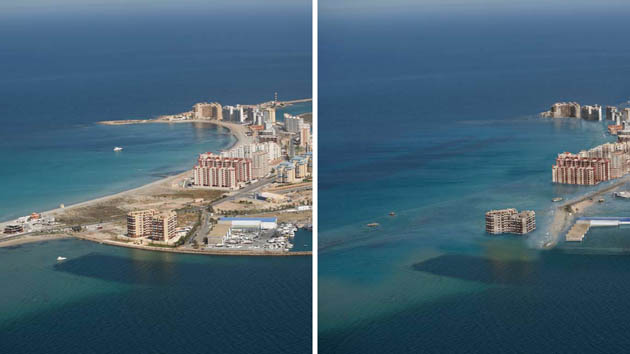 [Image: By Pedro Armestre and Mario Gómez].
[Image: By Pedro Armestre and Mario Gómez].The basic idea here is that these visions of flooded resort hotels, parched farmlands, and abandoned villages, half-buried in sand, will inspire us to take action against climate change. Seeing these pictures, such logic goes, will traumatize people into changing how they live, vote, consume, and think. You can visually shock them into action, in other words: one or two glimpses of pictures like these and you'll never think the same way about climate change again.
But I'm not at all convinced that that's what these images really do.
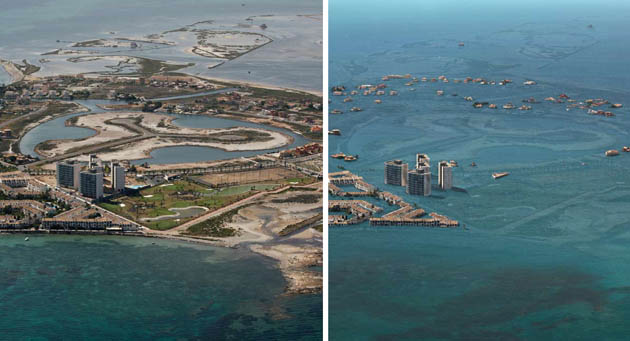 [Image: By Pedro Armestre and Mario Gómez].
[Image: By Pedro Armestre and Mario Gómez].In fact, these and other visions of altered planetary conditions might inadvertantly be stimulating people's interest in experiencing the earth's unearthly future. Why travel to alien landscapes when you can simply hang around, driving your Hummer...?
A few years go by and the planet is suddenly different.
So if the speculative landscapes pictured here are both imminent and immanent – if they are both inevitable and hidden inside the landscapes we see today, simply waiting for their opportunity to materialize (through drought, flood, fire, etc. etc.) – then there also seems to be a growing curiosity about what the world of tomorrow will really look like.
But mere seeing, I would guess, is not enough: I would assume, in fact, as more images of our climate-changed future are produced, that more and more people will simply gear themselves up to experience that future firsthand. If this is what's coming, then let's buy more bottled water.
Climate change is the adventure tour of a lifetime – and all it requires is that you wait. Then all the flooded hotels of Spain and south Florida will be yours for the taking.
Given images like these, the future looks exciting again.

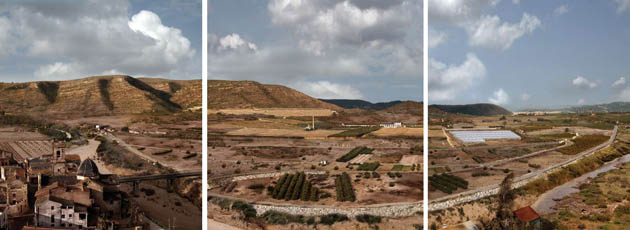 [Images: By Pedro Armestre and Mario Gómez].
[Images: By Pedro Armestre and Mario Gómez].Of course, such thinking is absurd; thinking that flooded cities and continent-spanning droughts and forest fires will simply be a convenient way to escape your mortgage payments is ridiculous. Viewing famine, mass extinction, and global human displacement into diarrhea-wracked refugee camps as some sort of Outward Bound holiday – on the scale of a planet – overlooks some rather obvious downsides to the potentially catastrophic impact of uncontrolled climate alteration.
Whether you're talking about infant mortality, skin cancer, mass violence and rape, waterborne diseases, vermin, blindness, drowning, and so on, climate change entails radically negative effects that aren't being factored into these escapist thought processes.
But none of those things are depicted in these images.
These images, and images like them, don't show us identifiable human suffering.
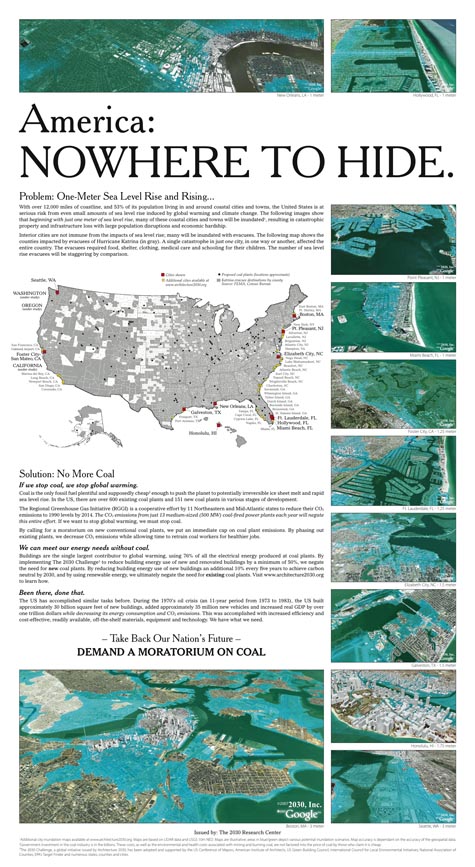 [Image: A full-page ad in The New York Times by Architecture 2030].
[Image: A full-page ad in The New York Times by Architecture 2030].So what do these images show us?
What we see is a world transformed, made unearthly, like something from a J.G. Ballard novel. Where there once was a pristine beach, the sea has returned, giving us modern ruins: sandbars in the lobbies of hotels, tide pools accumulating on the boardwalks of towns you didn't like in the first place. What appear to be coral reefs are the underwater remains of marinas. What look like atolls are lost subdivisions, or banks at the bottom of the sea.
Maintaining the J.G. Ballard reference, this description is from his book The Drowned World:
- Giant groves of gymnosperms stretched in dense clumps along the rooftops of the submerged buildings, smothering the white rectangular outlines... Narrow creeks, the canopies overhead turning them into green-lit tunnels, wound away from the larger lagoons, eventually joining the six hundred-yard-wide channels which broadened outwards toward the former suburbs of the city. Everywhere the silt encroached, shoring itself in huge banks against a railway viaduct or crescent of offices, oozing through a submerged arcade... Many of the smaller lakes were now filled in by the silt, yellow discs of fungus-covered sludge from which a profuse tangle of competing plant forms emerged, walled gardens in an insane Eden.
My point in saying all this is simply that these images don't shock; they're more like posters for tomorrow's specialty tourism firms.
After all, there is no one way to interpret these images; there is no singular narrative by which to understand them, or comprehend them.
Just look at photographs of New Orleans after Hurricane Katrina: that drowned city, for the political Left, became a symbol of all that is wrong with American Conservativism – that people like Dick Cheney would launch debt-fueled oil wars in the deserts of foreign countries while remaining blind to problems of national infrastructure back home – yet, for the political Right, New Orleans was a sign of what happens when you're forced to rescue, over and over again, a whole social class that refuses, or is systematically unable, to look after itself.
In other words, go show someone a photograph of New Orleans underwater – then tell me what they say that photograph "means" to them.
Then show them these images.
Then tell me what these images mean.
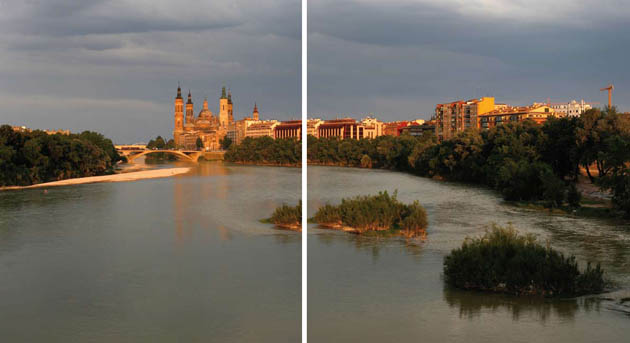
 [Images: By Pedro Armestre and Mario Gómez].
[Images: By Pedro Armestre and Mario Gómez].What are we supposed to take away from these scenes, then?
Does the religious Right look at these images and see what the political Left sees – or even what the financial Right sees, that opportunity-seeking managerial class of entrepreneurs and venture capitalists? What about New Age utopians? What about BLDGBLOG readers?
What about Muslim fundamentalists? Do visions of a submerged Manhattan make Hamas want to burn less oil?
Because there is not one singular explanation for these images; there is not one scientific narrative or political diagnosis that everyone will agree on.
Some people, as I've said, may even be excited: South Beach is under five feet of water...? Get your camera...
In any case, interpreting these Greenpeace images gets even more interesting when you reverse the original sequence in which some of them first appeared.
 [Images: By Pedro Armestre and Mario Gómez].
[Images: By Pedro Armestre and Mario Gómez].Let's say, then, that here, in the image featured above, we are looking at central California before corporate water lobbyists have pushed huge irrigation bills through Congress. We see unaffected Nature, with a capital N, with all its colors and rough edges: the water has yet to arrive, flowing in from distant pumps and reservoirs, and so Nature is still in balance with itself. It may be dry, in other words, but it is still vaguely Edenic.
Now, however, in the image below, let's say that this is what money, influence, and tightly controlled aqueducts will bring.
What should be desert, in other words – raw, beautiful desert – has become an apricot farm: gridded, geometric, and designed to turn a profit.
 [Images: By Pedro Armestre and Mario Gómez].
[Images: By Pedro Armestre and Mario Gómez].Again, my point is simply that these images lend themselves to a huge variety of interpretations – and so looking at them, in any order, can result in someone being offended, whether that someone is an environmentalist, a preacher, or a libertarian taxpayer.
And yet my intention is not to question – or, worse, trivialize – the effects of climate change, or to imply that the real danger of climate change is that someone will be "offended" by it; my intention is simply to question the visual rhetoric through which climate change is now being addressed.
How do we visually represent climate change in a way that will make more people take it seriously?
Because cinematic, quasi-Spielbergian images of drowned cities simply don't accomplish that.
Only half-jokingly, I might even suggest that the real way to scare people about climate change – assuming that fear is the correct tactic to use here – is not through referring to landscape at all, but through threats involving 1) sex and 2) children.
All that pollution... so much carbon in the atmosphere... dirty water, social unrest, lack of food...
Well, your prostate will swell with metal and your kids will all drown.
In any case, aerial views of an underwater Manhattan, or Romantic landscape photographs of the Spanish countryside, simply do not inspire people to turn the lights down or drive their Escalades less frequently.
If you want to use fear – and that's a huge if – then choose something scary.
As it is, we're being told that we should worry about climate change... because it resembles one of the most exciting tropical adventures ever to befall the human race.
Who's going to get upset about that?
(Remarkably similar thoughts can be found in BLDGBLOG's earlier post: Liberation Hydrology: Miami, 2107 A.D.).
No comments:
Post a Comment